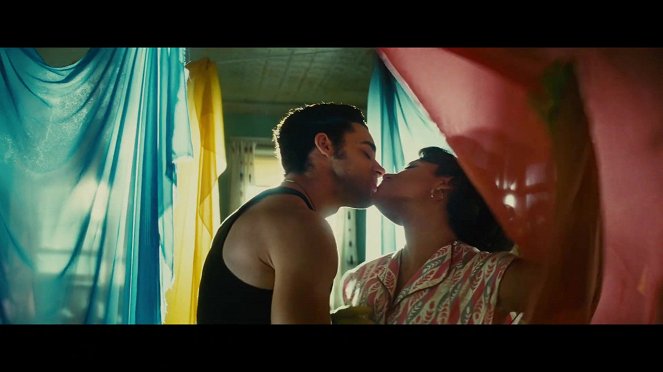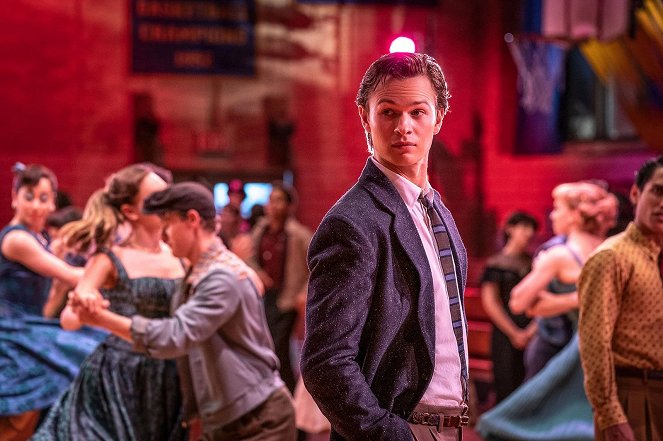Rendező:
Steven SpielbergForgatókönyvíró:
Tony KushnerOperatőr:
Janusz KaminskiSzereplők:
Ansel Elgort, Rachel Zegler, David Alvarez, Ariana DeBose, Rita Moreno, Corey Stoll, Brian d'Arcy James, Maddie Ziegler, Mike Faist, Ana Isabelle (több)Tartalmak(1)
Az Oscar-díjas Steven Spielberg rendezésében és a Pulitzer- illetve Tony-díjas Tony Kushner írásában készült West Side Story a könyörtelen rivalizálás és ifjonti szerelem klasszikussá vált történetét meséli el, New York Cityben, 1957-ben. (Fórum Hungary)
Videók (3)
Recenziók (8)
Since the opening scene of Indiana Jones and the Temple of Doom, Steven Spielberg has been waiting for his dream to come true and make a musical. And we waited with him, continually reassured by his impeccable sense of the fusion of image and music, that when it happened, it would be something. And finally, here’s West Side Story, And, of course, it is something. A firework of colourful directorial ideas that do not draw attention to themselves and, hand in hand with Bernstein's brilliant music, dance, rejoice, celebrate life and love for two and a half hours. A joy to look at, a joy to listen to. Any changes from the previous film are only for the better in my opinion, as many of the characters are more fleshed out and virtually no slightest plot line goes to waste. The biggest change is the Rita Moreno’s new character, but even she has her place in the plot, and is incredibly vital and sings like an angel at almost 90 years old. Ansel Elgort's acting reminded me immensely of a young Harrison Ford, his Tony is – again thanks to the script – much more interesting than Beymer's, and I think it was a great idea to put so many jokes in the song "Maria", even though it might seem that it doesn't fit. I hope we get to see Rachel Zegler and Ariana DeBose in future films because they are both adorable. This is certainly not the last time I’m watching West Side Story in the cinema.
()
After seeing West Side Story, it occurs to me that this is turning out to be a great year for musicals. Unlike Annette, which exhibits a clash of different poetics, West Side Story is, in its basic outlines, a pure musical melodrama about love that does not distinguish between good and evil; only its lack of an overture and intermission prevent it from being perfect. Spielberg and Kushner did not radically alter the timeless story of the multiple characters, who are prevented by violence, poverty and racism from fulfilling their dreams of building something of value on the ruins in which they live. Rather, they just fleshed out Tony’s past, added one important character (stylishly played by Rita Moreno), made the female characters stronger and more active, changed the order of certain songs, and made the motifs particularly relevant for the present day (racial violence, immigrants vs. white trash, tradition vs. foreign cultural influences). In comparison with the 1961 adaptation, the cast is more diverse (no whites playing Puerto Ricans, plus a lot of deliberately un-subtitled Spanish lines), as is the ensemble of characters (which include a trans boy). The actors, particularly Ariana DeBose as Anita, are fantastic, and the way Spielberg (or rather Kaminski) uses colour to differentiate the characters and bring clarity to the scenes in which several of them appear at once is admirable. Together with the specific lighting, choice of locations and camera movements, the colours also help to define the feuding sub-worlds, whose conflicts (whether physically, when the Jets and Sharks rumble at midnight, or in a parallel cut) are the emotional highlights of the film. And emotion is plentiful in West Side Story. The version from the 1960s, to which I returned a few days ago, is a nice colouring book and I watched it mostly with detached appreciation. Spielberg's treatment, which adroitly dances between the reality of the gritty New York streets and stylisation in the mould of classic Hollywood musicals, absolutely captivated me from the mambo in the school gym (which, like latter-day America, is a great, colourful celebration of life) and I just continued to be carried away, thrilled and moved by it. That’s not even to mention the clear arrangement of the dance scenes, the smooth tempo changes and the brilliant rhythmisation achieved through in-camera editing, which is not surprising for a director who also shoots action and comedy scenes as musical numbers. 90%
()
There are a lot of things about Steven Spielberg's new musical West Side Story that struck me after my first (and probably not last) visit to the cinema. Surprisingly not so much in terms of narrative, with Steven more or less alternating the perspectives of several key characters and subplots in a simple variation on Romeo and Juliet. At first I rather enjoyed the way in which the musical form is handled and how the musical numbers do not just drag out the runtime but serve the smooth unfolding of the story. Much of the film uses the genre of the musical as a diversion and embellishment rather than the main framework, which we see right away in the amazing opening sequence, featuring an inhospitable New York ghetto and two antagonistic cliques/sub-worlds – only the subtle drumming and whistling evokes a catchy rhythm, to which the camera movement and dance choreography adapts without being lavish and self-centred, but thoughtfully duplicating some action or movement of the characters towards some goal. In the opening, for example, the characters jump a fence, converge from all sides and engage in a street brawl, which takes the form of a carefully staged dance number. In this respect, the declared instability of the fictional world is also interesting, as the surrounding environment clearly does not accept that it is in the middle of a musical story with its own rules. The actors often block traffic or get in the way of passers-by – Spielberg deliberately stages multiple actions in a single take to protect those viewers who are not into dance numbers and singing from boredom and yawning. This changes in the middle of the romantic and melodramatic section, when instead much of the focus is on the singing, deepening emotion and empathy. Even then, the script doesn't let us fall asleep, and the creators make sure that the lyrics somehow develop the characters' feelings, thoughts about social disharmony or other personal motivations. The ending then drops the music altogether and focuses everything on the climax of the story of the three romantically intertwined characters, which does not leave one eye dry. True, the third act with the lengthy duet of the titular female protagonists grinds more than I am willing to accept with Spielberg, and the disarming narrative creativity stems from the individual sequences rather than the slightly lengthier whole. But there are enough admirable positives to tempt you to visit the cinema again. Again, the most creative passages are brilliant – the opening long take is completely immersive, the meeting between Tony and Maria is as magical as it gets, and the king of the film is the condensed parallel convergence to the expected battle between the two gangs. That's when Spielberg fully shows his greatness, and the cross-cutting between several characters whose different moods and expectations easily merge is a display of filmmaking mastery. And this, of course, applies to the audiovisual aspect as a whole, which the filmmakers have played with immensely – Kaminski's cinematography, alternating smooth movement during dancing and in interiors with shakiness in tense scenes, stunning lighting and shadow play, as well as the emphasis on the colour spectrum, clearly separating the two hostile sub-worlds. Fewer and fewer films offer so many appealing and interesting stimuli each year, and though I haven't seen some of the big players yet (or are waiting for us in the case of The Matrix and Paul Thomas Anderson's newcomer), I confidently call for at least four Oscars here (Best Picture and Director very likely, I wouldn't be surprised at all for cinematography and costumes, and maybe even for that perfect retro set design). If you can, go to the cinema – at least for an intimate date, there is perhaps no more appropriate and emotionally versatile film (though as a traditionalist I can't judge). 90 %
()
(kevesebbet)
(több)
Compared to the original, this spectacular revival of the classic musical benefits from its outstanding modern rendering and is thus catchier and has a generally quicker pace. The actors are great and the song-and-dance sequences are phenomenal. And the songs – not only about love and celebration of life, but also about discrimination and violence – have not lost their power and relevance even after all these years. Furthermore, they are performed in service of this great film, which boldly matches the qualities of its predecessor, showing us that the motif of racial conflict still remains a relevant social issue today.
()
If my heart has a space that says "West Side Story," it is already occupied by the 1961 movie. Everything is beautifully filmed in this one, and the choreography is perfect. It was carefully rehearsed and beautifully acted. However, we got the same thing with the sixty-year-old version, and apart from the superb craftsmanship, I cannot see much justification for making this reimagining.
()



Hirdetés